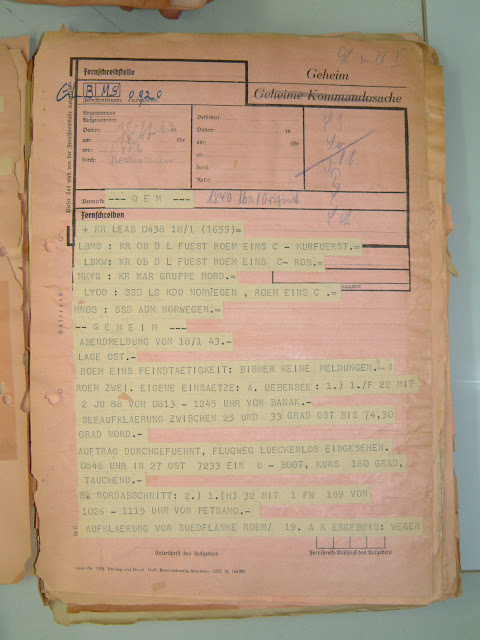As I have described the weekly and later on in the war strength reports from the Generalquartiermeister 6 Abt I thought I should present how these looked at Luftflotte level.
I have been fortunate to locate some examples of such strength reports from Luftflotte 5 - the center of my research interest - in the attachments to the war diary of said unit for October 1943.
These were collected daily and as you see they contained not only the number of aircraft and crews - but also the location of the unit.
Details on detachments were also included as shown in the below examples for II. and III. Gruppe of Jagdgeschwader 5, which both had a detachment (Kommando - abbreviated Kdo.) in Alta and at Pontsalenjoki respectively.
I am always interested in the columns of such reports - what do they represent - and what can we thus expect to find in more cryptic versions of these documents? By cryptic I refer to the teleprinted versions of these reports which would be sent to higher commands in abbreviated and shortened form - often as numbers with the letter x as divider.
For these reports we have the following columns:
I have been fortunate to locate some examples of such strength reports from Luftflotte 5 - the center of my research interest - in the attachments to the war diary of said unit for October 1943.
These were collected daily and as you see they contained not only the number of aircraft and crews - but also the location of the unit.
Details on detachments were also included as shown in the below examples for II. and III. Gruppe of Jagdgeschwader 5, which both had a detachment (Kommando - abbreviated Kdo.) in Alta and at Pontsalenjoki respectively.
I am always interested in the columns of such reports - what do they represent - and what can we thus expect to find in more cryptic versions of these documents? By cryptic I refer to the teleprinted versions of these reports which would be sent to higher commands in abbreviated and shortened form - often as numbers with the letter x as divider.
For these reports we have the following columns:
- Verband
- Ort
- Flugzeuge
- Muster
- Soll
- Ist
- Dazu zugewiesen, nicht übernommen
- Klar
- Einsatzhafen
- Ausserhalb
- Besatzungen
- Ist
- Einsatzbereit
- voll
- eingeschränkt
- Einsatzfähig
- Vortag
- Unit
- Location of the unit - airfield, landing ground or station
- Aircraft
- Aircraft model and subtype
- Established strength (number of aircraft)
- Current strength (number of aircraft)
- Additional number of aircraft allotted but not yet taken on strength
- Number of aircraft ready for operations
- At the reported airfield, landing ground or station
- In other locations
- Aircrew
- Current strength (number of complete crews)
- Number of aircrew ready for operations
- Fully ready
- Limited readiness state
- Summary - count of aircraft and crew to use for the tactical operational state of the unit on this date
- Summary - count of aircraft and crew to use for the tactical operational state of the unit on the previous day
And as always I check the Verteiler - the list of units which this document was distributed to in copy. As you can see here this copy is the one that was distributed to the Ia - the head of operations. In addition copies of this document was distributed to:
- Chef der Generalstab
- Two copies to different offices of the Oberquartiermeister
- One to the Gefechtsstab located in Kemi, Finland
- One copy to the chief engineer, Chef - Ing.
- The last copy to the Luftgaukommando Norwegen.
In following the paper trail one can expect to find copies of these in all the above mentioned archives or war diaries - and although most of the Luftwaffe archives was destroyed you can get lucky!
Enjoy and have a nice day!







